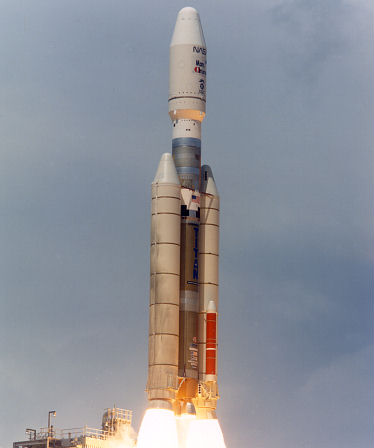COMMERCIAL TITAN III FACT SHEET
By Cliff Lethbridge

Commercial Titan III Launch, Photo Courtesy NASA
Classification: Space Launch Vehicle
Length: 144 feet, 7 inches (with single payload)
155 feet, 2 inches (with dual payload)
Diameter: 10 feet
Date of First Cape Canaveral Launch: December 31, 1989
Date of Final Cape Canaveral Launch: September 25, 1992
Number of Cape Canaveral Launches: 4
Introduced in 1989 to meet the needs of commercial clients, the Commercial Titan III featured several major improvements over the Titan 34D upon which it was based. The Commercial Titan III could carry one payload or two separate payloads at the same time. It also employed upgraded first and second stage engines and enhanced solid rocket boosters. Two United Technologies solid rocket boosters were able to produce a combined thrust of 2,800,000 pounds. Each solid rocket booster was 90 feet, 5 inches tall and 10 feet, 2 inches wide. The Aerojet dual chamber first stage engine could produce a thrust of 547,950 pounds, while an Aerojet second stage engine could produce a 105,000-pound thrust. Both the first and second stage engines burned Aerozine 50/Nitrogen Tetroxide liquid fuel.
The Commercial Titan III could incorporate several different third stages depending upon the individual requirements for each customer and payload application. Third stages available to be flown on the Commercial Titan III included the Inertial Upper Stage (IUS), Centaur G-Prime, Transfer Orbit Stage (TOS), Payload Assist Module (PAM) and Expendable Shuttle Compatible Orbit Transfer System (ESCOTS). Additional flexibility for customers included the ability of the Commercial Titan III to carry up to two payloads at the same time. In the dual payload mode, the payload fairing separated into halves at about four and one-half minutes into the flight. The first payload was deployed about one hour into the flight, while the second payload was deployed about two and one-half hours into the flight.
In general terms, although the specific performance capabilities of the available upper stages varied, the Commercial Titan III was able to carry a single 31,530-pound payload or combined 32,430-pound dual payload to low-Earth orbit. In other applications, the Commercial Titan III could carry a 25,740-pound payload to space station transfer orbit or a 10,980-pound payload to geostationary transfer orbit. Able to support the launches of NASA planetary spacecraft, the Commercial Titan III could carry a 7,480-pound payload on a lunar trajectory or a 5,720-pound payload on a Mars or Venus trajectory.


